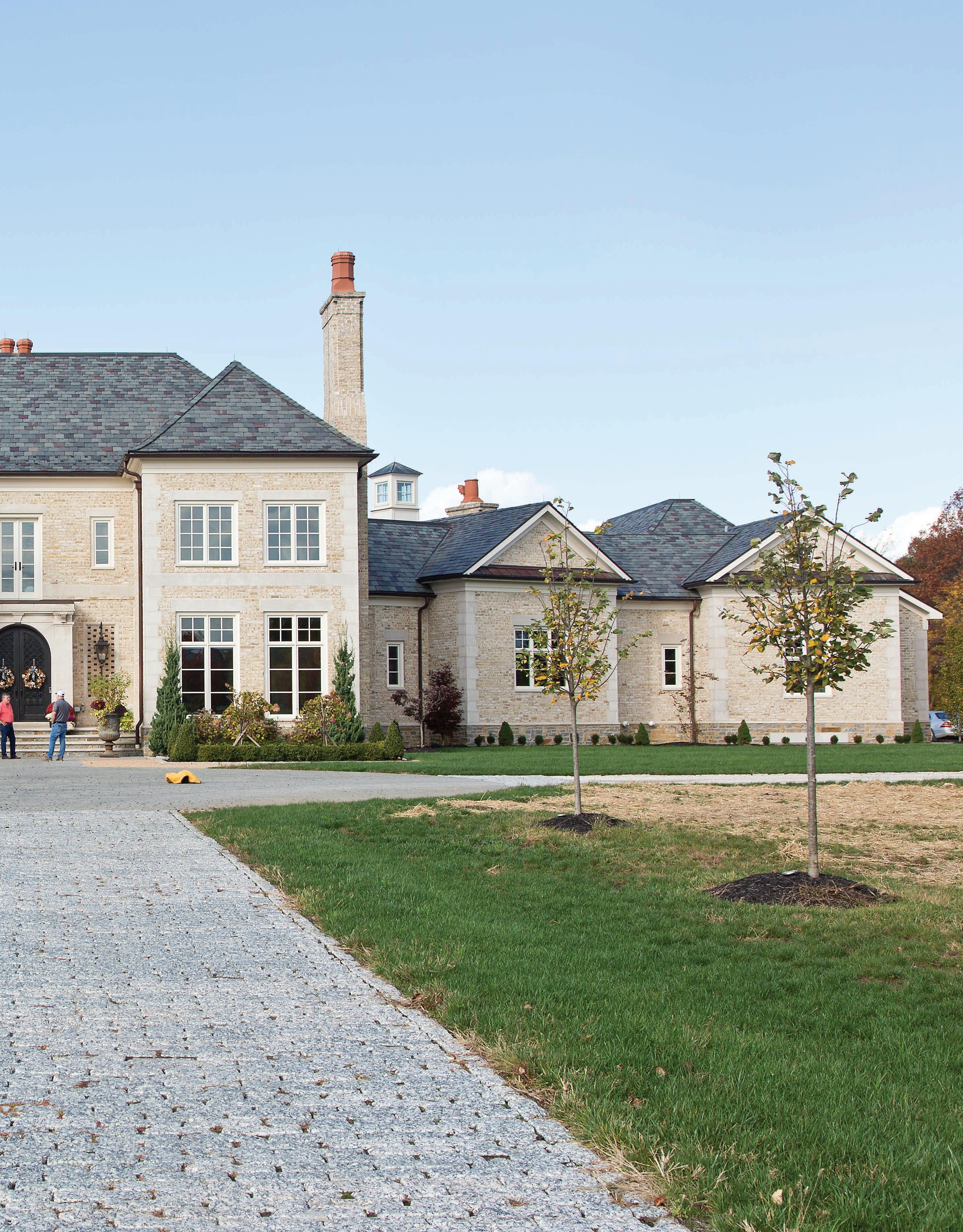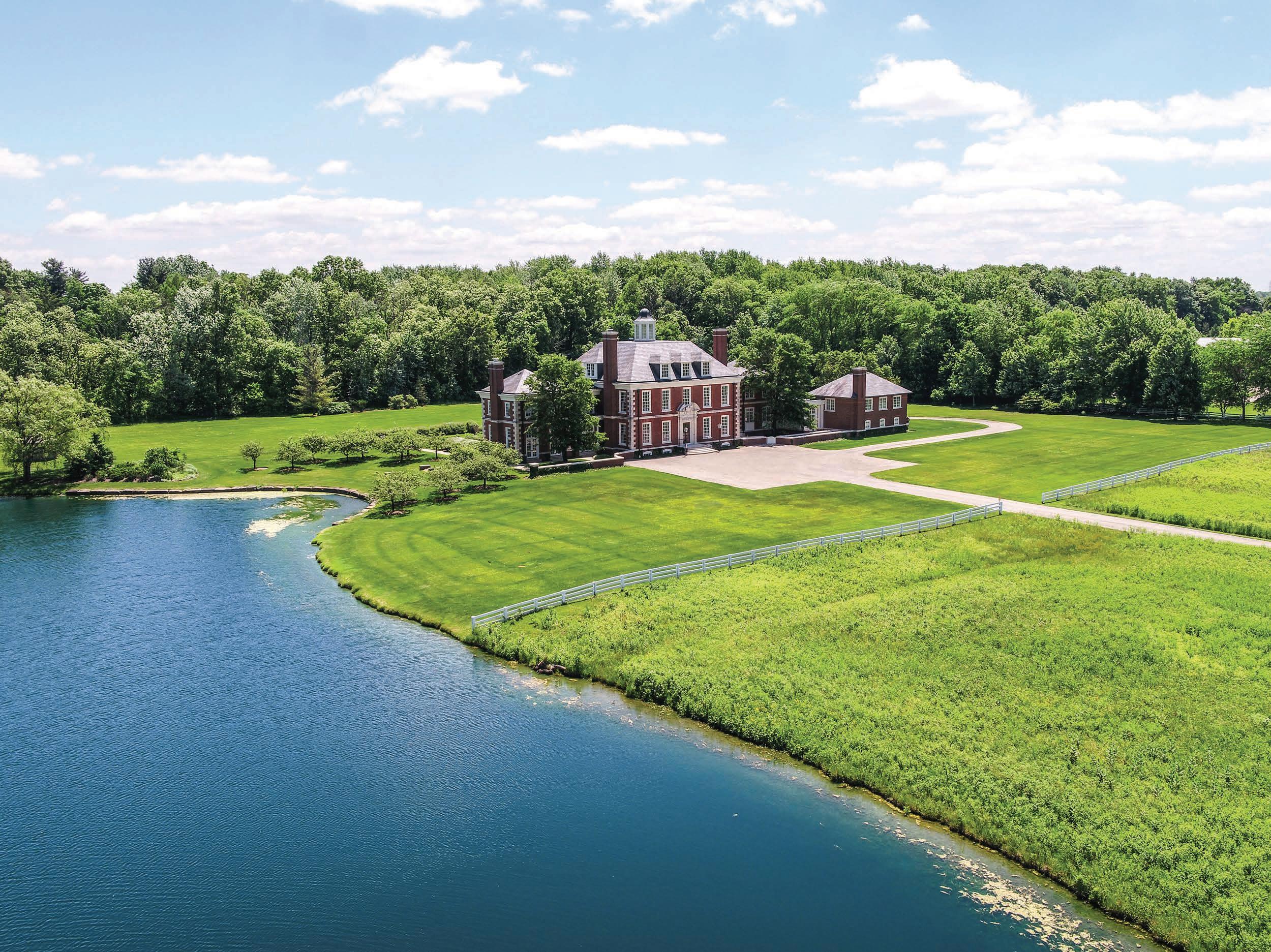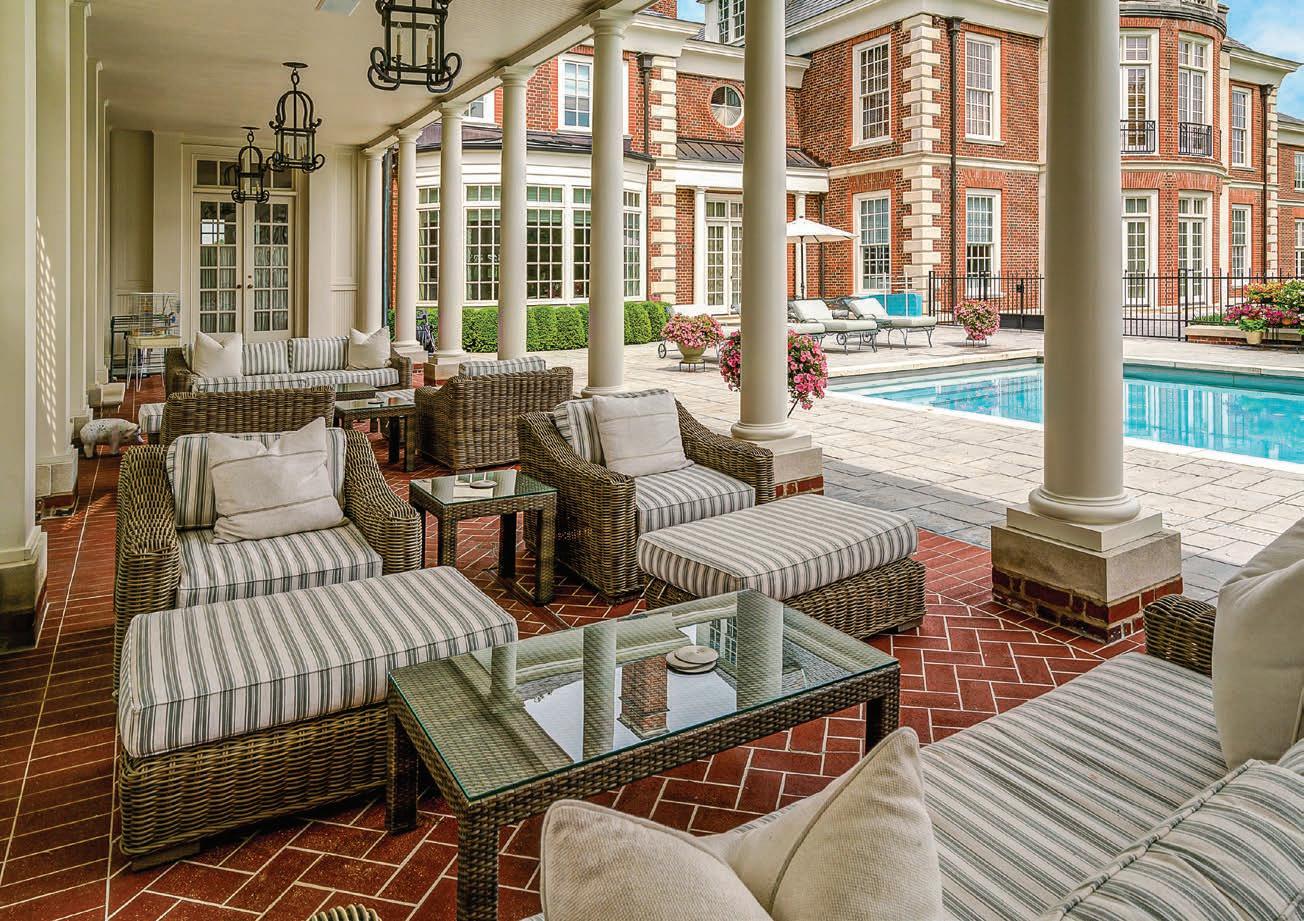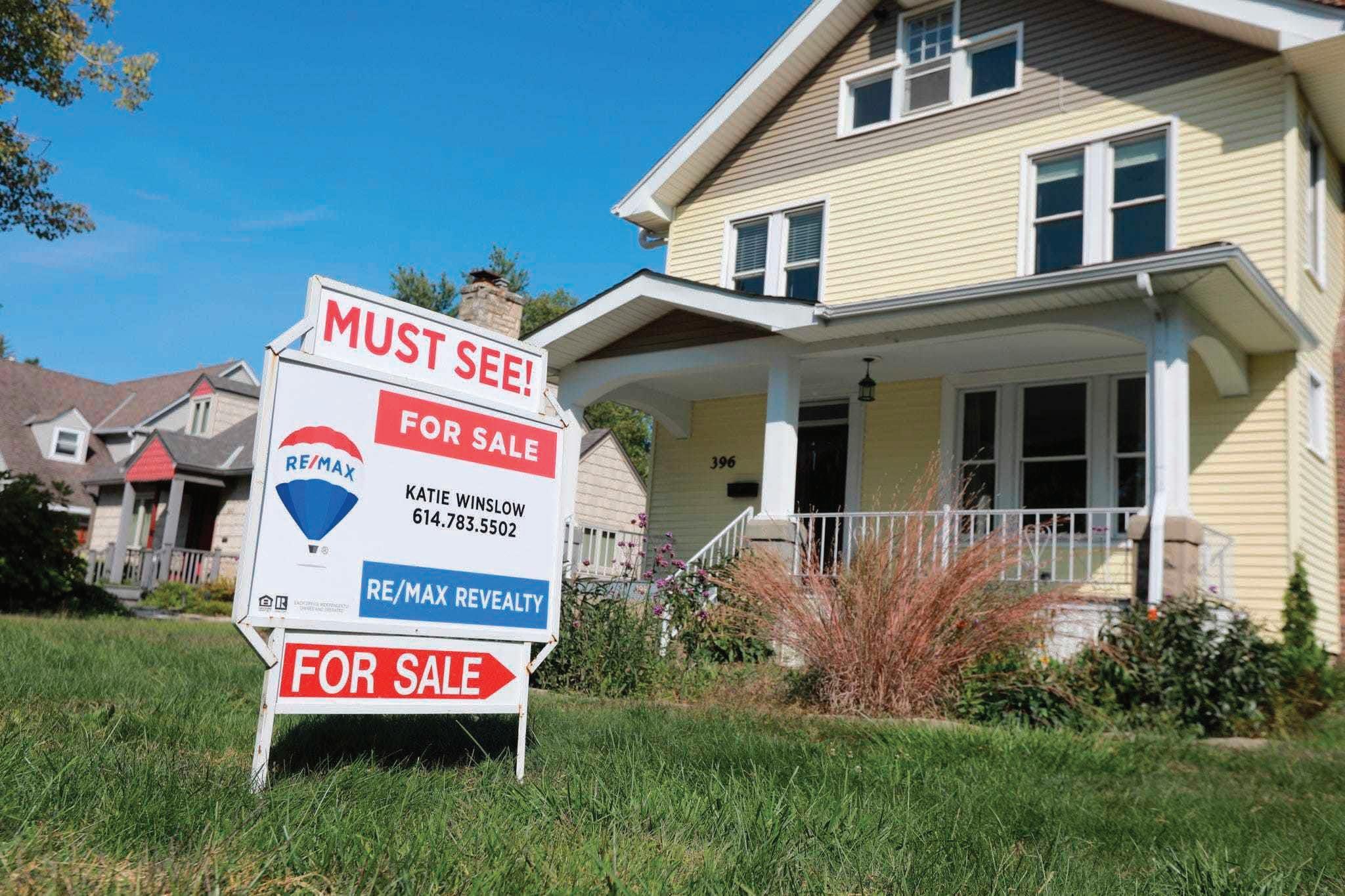
9 minute read
Home & Style | Home
New Albany New Albany Farms Farms
Ron Guzzo, left, and Joe Garner are in front of one of the homes they built in New Albany Farms.
More than 30 years ago when Les Wexner envisioned his personal estate, he designed one of Central Ohio’s most exclusive communities for his neighbors, and it continues to thrive.
When L Brands founder and now-retired chairman Les Wexner and his friend Jack Kessler took a legendary ride on the country roads of Plain Township nearly 35 years ago, the pair began to envision an uber-upscale community. They thought it should be anchored by the region’s best golf club and, eventually, a business park to financially support the creation of a wellplanned community that encompasses an exemplary school district, health clubs, cultural events and other amenities.


The New Albany home of former Express CEO Michael Weiss and his wife, Arlene, went into contract for sale this fall.
Around the same time, Wexner had a vision for what would become his personal estate of about 300 acres and its organic farm. Just south of his estate, he worked with planners to carve out 23 large estate lots that created the gated New Albany Farms neighborhood. He anticipated that this is where a select few executives and top professionals in the region would enjoy rural living, and still be within the country club community.
Count twice-retired Express chief executive Michael Weiss among the early highprofile folks who decided to take advantage of the opportunity. Contrary to beliefs at the time, Weiss says he never felt pressure to move from Bexley—Wexner’s hometown— to the exclusive, gated community of New Albany just to please his boss. “I never felt pressure to build in the Farms,” Weiss says. “I really wanted—given the opportunity—to design and build a home. It was an opportunity for self-expression.”
The house he and wife, Arlene, built in the 1990s, and recently contracted to sell, was conceived “as an 18th century Georgian house … but with 1990s sensibility and technology,” explains Weiss.
“It has the gracious feeling of the 1920s when people built grand-looking houses,” he continues. “We took the best from [architectural] history.”
The home, measuring nearly 14,000 square feet, includes six bedrooms and six-and-ahalf baths, according to its MLS listing. It was offered for $3.3 million and was expected to transfer to its new owner on Dec. 1.
That 11-acre estate sits in the midst of a well-manicured lawn with a large lake behind a meadow of tall grass that lines New Albany Farms Road. That common area—maintained by the homeowners’ association—serves as a setback to create the country theme of the luxury neighborhood on large, open lots within the broader New Albany Country Club community. Woods grace the back of the property, while trees also obscure some of the neighboring residences. Stringent design standards guided


A grand entry in the Weiss home has welcomed hundreds of visitors through the years who attended personal, business and philanthropic events there. Below, the loge provides a comfortable resting space near the home’s swimming pool.
development of the premier homes that were built there.
“We thought the country farm theme would be an extra attraction suited for homes on the largest lots and at the highest price points,” explains Kessler, long-time chairman of the New Albany Co., which directs residential and commercial projects in New Albany. “It worked.”
Kessler expresses satisfaction with New Albany Farms hamlet, which has a gated entrance off Kitzmiller Road between Morse and the old Ohio 161.
Little can be seen of the neighborhood from Kitzmiller or Reynoldsburg-New Albany Road, which borders the community on its west side. Trees that were planted when the neighborhood was new have now grown taller than the homes there. “It’s nice to see it completed,” Kessler says, “and the last homes built.”
A drive through the Farms with Kessler’s daughter, New Albany Realty agent Jane Kessler Lennox, shows the care in the planning and execution of the development. A resident of the area, she and her husband, Thomas Lennox, the former Pelotonia nonprofit’s CEO and current founder and president of the DIB Brands marketing/design firm, have had some well-known neighbors during their 17 years inside the gate.
The late IndyCar driver/owner Bobby Rahal and his ex-wife Deborah Berry once owned a property complete with a horse barn. Berry later lived in another Farms home after the couple divorced. Retired White Castle CEO Bill Ingram and his wife, Martha, also live in the enclave. So does noted joint implant inventor and surgeon Dr. Adolph Lombardi and his wife, Anne. Central Ohio businessman Glenn Leibert also owns an estate there.
“It’s kind of a who’s who,” says homebuilder Ron Guzzo of Guzzo & Garner Custom Homes, which has built three houses within the neighborhood. The Farms “is the crown jewel of the New Albany Country Club community,” says Guzzo.
Among the first homes built were those belonging to the Weisses and the Lennoxes.
Guzzo, left, and Garner built three of the large homes in New Albany Farms.
Several more were built through the rest of the 1990s. Another batch got built in the 2000s. While nearly all are built to resemble grand rural estates, one home has the architectural theme of a barn, made of post-and-beam construction complete with a silo.
“These are special, special homes,” Guzzo says. “The Farms architectural review committee has extra incentive to make [all] homes nice because the Wexners live nearby.”
Guzzo helped Columbus cosmetic surgeon Walter Bernacki and his wife, Polly, design a home eight years ago after they bought the last undeveloped Farms lot. Bernacki said he wanted to apply his aptitude for details when they decided to move to New Albany from Westerville in the design of a home built without simulated brick and other corner cutting. “We wanted to use old world materials such as limestone, slate for the roofs and copper in the eaves. We didn’t just want a great house,” Bernacki says. “We wanted a house that works for our family.”
Bernacki’s 8-acre property takes on the flavor of a French country home featuring wood beams, antique stained-glass doors and a limited use of natural stone. It also features a lake complete with fish and, Bernacki’s favorite feature, a covered loge with an outdoor fireplace for relaxing dinners and entertainment.
The property also affords Bernacki the opportunity to engage in his favorite hobby: gardening. He focuses on both a vegetable garden and the formal gardens on the estate grounds. Building the home new “provided us with a blank slate,” he says, noting that he and his wife enjoy doing their own gardening rather than hiring it all out.
Despite her husband’s enthusiasm, Arlene Weiss confesses that initially she was not at all that thrilled with moving to New Albany after 14 years living in Bexley. To begin with, she worked at the Buckeye Boys Ranch in Grove City, so the commute to work was significantly extended. She says New Albany in the mid-1990s also lacked many amenities, such as nearby shopping. “We’re New Yorkers,” she says. “To move to a place without the retail nearby was sort of a shock. I was so grateful when Easton opened, because of the variety of retail.”
The couple has transitioned back to urban living, buying a condo at Miranova overlooking Bicentennial Park in Downtown Columbus, visiting their New York City place and other destinations. Urban retirement suits them just fine as it’s part of a familiar big city transition. “In New York,” the retired CEO says, “people step up from the suburbs to a wonderful apartment on Central Park.”
He notes that the large home they built in the Farms proved most accommodating as the site of business dinners and charity events. “We’d have a Christmas party for 100, easily. Black tie events,” says Michael Weiss. “People do live in just a few rooms. If you do a lot of entertaining, others get used and that makes it worthwhile. The minute those gatherings ended, the house felt excessive.” ◆


Housing Shortage
Just building more homes doesn’t solve Central Ohio’s growing demand. By TC BRown
Central Ohio’s real estate market has more buyers than existing homes, so why aren’t builders just building more houses to fill the demand?
The hard reality of a red-hot housing market is that it is not that simple. First, the median price buyers paid for a house in the fall was $240,000. While that was $34,000 higher from the previous year, it was way less than the minimum price of a new build.
“They can start in the low $300,000s but that is about as small a house as you can build,” says Vince Squillace, executive vice president of the Ohio Homebuilder’s Association. “The market is underbuilt and it is exacerbating in Columbus because we have great population growth with great demographics for construction.”
Three million people are expected to call Central Ohio home by 2050, an increase of one million residents. So, permitting activity needs to increase two- to three-fold to meet projected housing needs, according to Vogt Strategic Insights, a real estate research firm.
A Mid-Ohio Regional Planning Commission housing study released in September was topped with a headline that “Central Ohio is at a critical inflection point.” The report noted that as more homes are built at higher price points, existing affordable options are lost.
For demand to be met, something must give, say builders and real estate agents. Developers say their hands are tied by land availability, zoning, density restrictions, regulations, construction costs and a lack of skilled workers.
Jim Lipnos, president of the Homewood Corp., says with the current tight market, buyers are in stiff competition for affordable housing, but the cost of a new house puts it out of reach for many.
“New housing gets so expensive it is not an option for some people,” Lipnos says. “Where there is a housing shortage on
A Clintonville home for sale
either side of new or existing, it definitely impacts the other side.”
In the fall, just under 3,000 homes were listed in the market, about half the number from the previous year.
While the average price for a new home is around $340,000, up to 30 percent of that cost is dedicated to meeting regulations. Another challenge for developers is density limits imposed by local communities, says Jon Melchi, executive director of the Building Industry Association of Central Ohio.
“The size of the lot … drives up the cost significantly and that is the biggest challenge we have with local governments,” Melchi says. “They want large lots. Some consumers want that but most new homeowners don’t.”
Creativity to attract buyers is often employed, says Doug Turlow, a broker and owner of Home Central Realty.
“They might offer some sort of financing incentive say on a $350,000 home where you are paying the same as a $325,000 existing home so it makes up the difference,” Turlow says. “They try to make it where it equals out a bit.”
Meanwhile, as Turlow and others say, “The market is through the roof.” ◆










